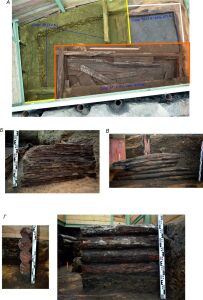 Roman N. Modina,# and Vladimir Yu. Kovala,##
Roman N. Modina,# and Vladimir Yu. Kovala,##
aInstitute of Archaeology RAS, Moscow, Russia
#E-mail: modin.roman@mail.ru
##E-mail: kovaloka@mail.ru
Keywords: archaeology of Moscow, the late Middle Ages, cultural layer, estate layout, cellar, log house.
The wooden structures that were part of the manor complexes of the 14th – the first half of the 16th century AD are the remains of above-ground structures and cellars dug into the ground. The latter were log frames placed in a pit dug for them. Most of the log frames were made of oak or young pine and spruce logs, which prevent researchers from obtaining a series of reliable dendrochronological dates. The above-ground (residential and economic) structures have survived in a worse condition, some of them perished in a fire at the end of the 15th century AD. Remains of ovens made of raw bricks are associated with residential buildings. The compact arrangement of the studied structures, the construction of cellars and ovens on the same site testifies to the stable layout of the estate space for a long time – from the 14th to the middle of the 16th century. At the end of the site functioning period, a very large cellar up to 5 m deep appeared on it, which could be related to the temporary court of Ivan III at the end of the 15th century.
DOI: 10.31857/S086960632304013X, EDN: HEIAPV







